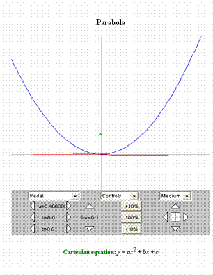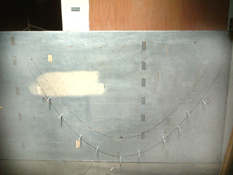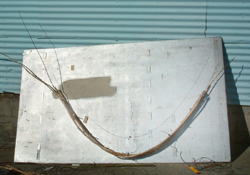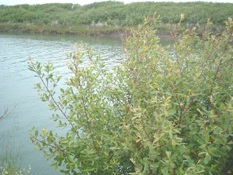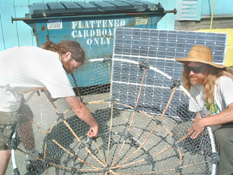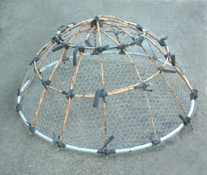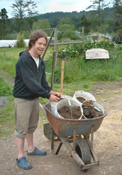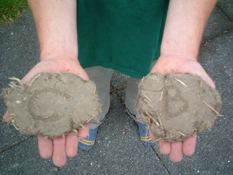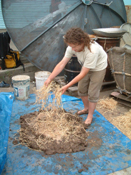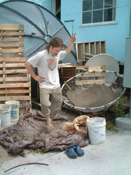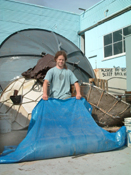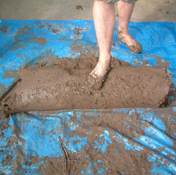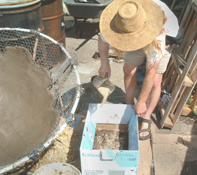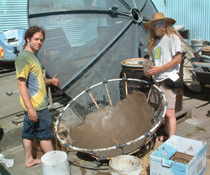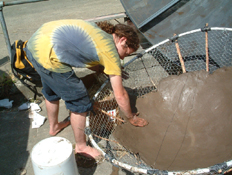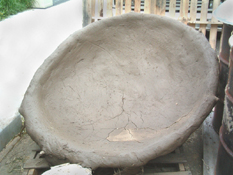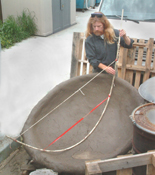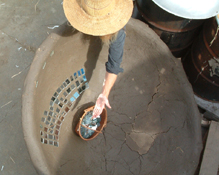By Ducan McIntosh and Bart Orlando 2005
Introduction:
We set out with the goal of building a parabolic solar cooker using techniques
and materials available in developing (non-industrialized) countries. We also
adopted a deep focus design that minimizes the chance of eye damage and starting
accidental fires by focusing the sunlight near the vertex of the parabolid. Such
a design could be used for a variety of purposes including; boiling water, cooking,
baking and telecommunications. For a complete explaination of parabolic solar
cookers please access the website for the CAMPUS
CENTER FOR APPROPRIATE TECHNOLOGY AT HUMBOLDT STATE UNIVERSITY.
When creating a cob basket, finding the most appropiate material possible is key. The material must be flexable enough to bend into a parabola, yet rigid enough to keep its form. Willows grow near pretty much every body of water in Northern California. Willows are used by local craftsmen for furniture and art. They have also been used in sweatlodges for longer than history can tell. It seemed that willow was the best candidate for the job.
The next step in this research would be to to figure out depth and size of the parabola. This is achieved through a program with an algebraic interactive graph available on the CCAT website. The equation for the curve is y=ax^2. By varying the coefficient of "a", the width and depth changes.
Several values for "a" were considered, ( a =.2, .3, and .4). Once the three values for "a" are obtained, they were downloaded, printed out and copied onto tranceparancies.
With the help of an overhead projector, the parabola was displayed onto a scrap sheet of plywood. By moving the overhead projector closer or farther away from the plywood we adjusted the size overall size of the parabolic image. We decided to select "a" = .4 because it would allow us to create a deep focus paraboloid. This shape, we resoned, would yield the safest and most efficient design.. Because 41/2 feet diameter satalite dishes works Also it was decided that four and a half feet was the most.
Constructing The Jig:
Once
the parabola size and shape established, the next step is to create a jig. With
the parabola containing the right size and shape, projecting against the plywood,
the outline is traced onto the wood with a permanent marker. To double the amount
of willows cured. Raise the projector six inches and trace again.
Using the
board as a jig, holes are drilled into the parabola outline and 8 inch carrage
bolts are put into the holes. These are used to secure the willow into place.
About nine carriage bolts are put into each parabola. The willows are put into
the jig and the secred with rope. They are allowed to cure for about two weeks
before they are dry enough to keep their form.
The key to using willow as a structural material is to find willow that is straight, flexable and with a minimal amount of knots. The the best place to find willows of this stature is near a river whose water level changes dramatically. This is because, the willow must be flexable enough to withstand the pressure of the flooding water. Willows that grow next to the Trinity River are perfect. They are long straight and contain minimal knots. To minimize the impact on the environment, large thickets of willow were the chosen places to harvest the willow branches.
When the willows are freshly cut, they are not flexable enough to flex into a parabolic curve. To remedy this, they were soaked in the Mad River for about a week. They became very flexable. The willows were peeled to speed up the process of curing.
The rim of a four and half foot parabola is about fifteen feet. The harvested willow wasn't anywhere near that length. So, Bamboo was tried. Freshly harvested the bamboo wasn't very flexable. After a month of soaking in the river it was still not flexable enough to bend into a complete circle. PVC pipe was the only material that was long enough and flexable enough to create a four and a half foot circle.
Using scrap pieces of bike inner tubes, the willow branches were attached to the the PVC pipe. Structural support is needed on the bottom of the basket, so a salvaged 24inch bicycle rim worked perfect.
The leftover willow branches were used as structural support between the rim plane and the bike rim
TESTING COBB
MATERIALS:
The stray and sand were purcahased at local feed and construction retailers. The clay was donated from the Arcata Community Farm. There were almost a dozen test bricks made with various amounts of clay, straw,sand, and water. They were cooked in an oven at 150 degrees (f) overnight. A ratio of six parts clay, one part sand, one part straw and one part water held up best against the heat, and durability test (dropping it on the ground from a hight of about four feet).
After obtaining the raw clay, it was graded through a 1/2 inch wire screen. This was done very carefully to protect the lives of as many earth worms as possible. Each batch made about fifteen gallons of cobb. The clay was poured onto a tarp. Slowly and evenly the straw, sand, and water were added. This was a process of smashing the cobb into a flat patty, rolling it up in the tarp to create a cob roll, then smashing it back into a patty. This was done over and over until the cob was thoroughly mixed.
Through trial and error, it weas realized that for this particular project, the best way to apply the cob was in sheets of various sizes. The cob was smashed into one gaint patty, cut into individual peaces and applied evenly. The patties were aproximetly three inches thick, with one third of the mass pushing through the chisken wire. This garenteed that the cob would be tightly secured to the wire.To completly cover basket, we used aproximetly 60gallons (four batches) of cob.
As the cobb was applied, the basket began to settle under the weight of the moist clay and sand. . A tool shaped like the parabola y=.4x^2 was made of a section of cpvc using the willow drying jig as a template. The tool was set along the inside of the basket to check for discrepancies between the shape of the cobbed basket's concave surface and a true parabolic cuvature. More clay was added in the places where depressions occurred. bring the basket back to the right shape. As a result the cobb parabolid is a little shallower then originally intend. The shape of the rim plane also changed from a circle to a more irregular shape..
FUTURE
WORK:
In about a month, after the cobb has had time to dry completly,
it will be time to attach small cut pieces of salvaged broken mirrors. Using a
thick lime plaster and the sun, each mirror will be manuvered to aim at a focus
point. Once it is dried in place, the cooker will be moved via forklift and flat
bed truck to the Arcata educational farm, where it will live permanently .
Since
the mirror fragments are created using a thin layer of silver
on the back side
of the glass, they will reflect micro waves as well as sunlight. Therefore, the
cobb solar cooker will also be capable of functioning as a satellite dish.
NEXT TIME:
To
make the cooker lighter, the, cob will nit be used. one option might be to line
the basket with just a lime or other plaster
.
Another option might be to
use thin strips of spring steel wire or steel tubing in place of the willows.
This will make the basket tramendously stronger. Then strips of polished aluminum
cans can could be used as a substitue for the glass mirrors. This would make the
cooker much lighter.
A parabolic trowel would make the process of smoothing
and shaping the cobb and plaster easier.
IN
HINDSIGHT:
The PVC pipe was not the best option. It was too flexible.
The rim needs to be rigid and strong enough to hold the weight of the cobb.
Some
of the willows we used were pretty thin towards the ends. This led to more settling
of the parabolic basket.. If all the willows were at least 1/2 inch in radius
(at both ends), the structure would be much stronger.
This project is best
suited for a large group of people to take on
because of the amount of time
and energy needed in preparing and applying the cobb. It would be ideal for an
elementary school class project.
The cobb cooker should be built on sight, at the spot where it is to be displayed.
This project is best done in the
summer so that there is plenty of sun and warm weather to speed the drying processes.
